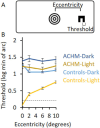Intact high-level visual functions in congenital rod-monochromacy
- PMID: 39399382
- PMCID: PMC11466936
- DOI: 10.3389/fnins.2024.1418916
Intact high-level visual functions in congenital rod-monochromacy
Abstract
High-level visual functions such as reading and face recognition rely on global processes, which are often insensitive to high spatial frequencies. However, it is unknown whether a sharp cone signal is necessary for the development of these skills or whether a blurry rod signal is sufficient. CNGA3/B3-achromatopsia is a congenital disease stemming from cone dysfunction, leading to rod-only vision characterized by nystagmus, impaired acuity, and complete color blindness. We tested reading and face recognition in CNGA3/B3-achromatopsia patients (ACHM) to determine whether a rod signal is sufficient for these skills to develop. We tested 10 ACHM and 10 controls in three experiments under dark and light conditions. Initially, we evaluated acuity along the eccentricity axis. Later, we tested reading speed and upright/inverted face matching accuracy while tracking participants' eye movements. Given that ACHM patients' acuity under light conditions resembled that of controls under dark conditions, we selected these conditions for comparison. Remarkably, ACHM reading speed, face recognition abilities, and susceptibility to face inversion were not inferior to those of controls. Additionally, ACHM patients exhibited similar eye movements to controls, focusing their attention on specific areas of words and faces that indicate expertise. Despite the evident low-level limitations, ACHM patients demonstrated notable high-level visual skills, suggesting that rod-only vision is sufficient for the development of proficient reading and face recognition. These findings not only corroborate empirical evidence for high-level vision models but also enrich the discussion regarding the reasons for high-level deficits observed in individuals who have gained sight late in life.
Keywords: CNGA3; CNGB3; achromatopsia; faces; monochromat; reading; rods; scotopic.
Copyright © 2024 Shabat, McKyton, Elul, Marks Ohana, Nahmany, Banin and Levin.
Conflict of interest statement
The authors declare that the research was conducted in the absence of any commercial or financial relationships that could be construed as a potential conflict of interest.
Figures



References
-
- Burton E., Wattam-Bell J., Rubin G. S., Aboshiha J., Michaelides M., Atkinson J., et al. . (2016). Dissociations in coherence sensitivity reveal atypical development of cortical visual processing in congenital Achromatopsia. Invest. Ophthalmol. Vis. Sci. 57, 2251–2259. doi: 10.1167/IOVS.15-18414, PMID: - DOI - PubMed
LinkOut - more resources
Full Text Sources

